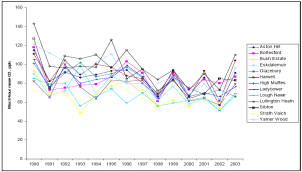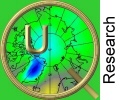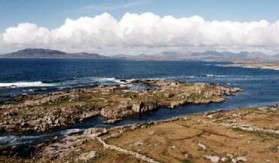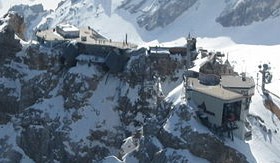
> ACCENT en > UQ 3 May 07 Cars and ozone > R: Ozone trends
|
|
 |
Research A: Ozone Trends
(results from ACCENT)
Research in the ACCENT project on Atmospheric Composition Change has a strong focus on ozone in the troposphere and the boundary layer. The troposphere is the lowest layer in the atmosphere where all weather events take place. The boundary layer is about the lowest 1-2 km of air close to the ground, just the air we are breathing every day.
|
Ozone is not healthy. In high concentrations it is really harmful, for our respiratory tract and also for vegetation. An important reason for ozone formation is that emissions of nitrogen oxides (NO and NO2) are released into the air. In urban areas nitrogen oxides come primarily from road traffic and industry, on the oceans also from ships. But they have also natural sources like vegetation fires and lightning.
|
 |
 |
 |
|
1. The planetary boundary layer is the tropospheric layer closest to the ground. © NOAA
|
|
 |
 |
|
2. Recent ozone trends from several northern hemisphere ground-based stations. Source: ACCENT, Answers to the Urbino Questions
|
|
 |
In the engines of cars, trucks and busses it is so hot that atmospheric nitrogen (N2) is oxidised. Catalytic converters have helped a lot to reduce the emissions and to decrease ozone peak values. But the problem is by far not yet solved. However, it is not only nitrogen oxides, also the increase of methane and the concentration of carbon monoxide (CO) and hydrocarbons in the atmosphere have impacts on the formation of background ozone.
|
|
The mountain peak of Zugspitze (German Alps) and Mace Head (observatory at a lonely place of the Irish coast) are two stations in Europe, where the air is usually clean and less influenced by cities. But the ozone level has been increasing here over the last two decades.
|
|
This is partially because emissions of ozone precursors from human sources have been increasing globally in the second half of the 20th century. They are transported over long distances, for example as peroxyacetyl nitrate (PAN). Now nitrogen oxides are decreasing in some industrialised countries, but a lot of ozone is still imported. We spoke about this and the transport in ACCENT magazine No 8: Background ozone and long distance transport of nitrogen oxides
http://www.atmosphere.mpg.de/enid/5og.html
But the figure also shows: Ozone production is a part in complex atmospheric chemistry and can vary from year to year and station to station.
In rural areas in United Kingdom concentrations were slightly decreasing.
|
Relevant amounts of nitrogen oxides are still formed in urban areas and reduction strategies are less successful than for other air pollutants. The partial reduction leads to the effect, that less ozone is destroyed by reactions with NO in the city, but there is still enough NO and NO2 to drive ozone formation. Therefore ozone increases in the city centres. Only drastic reductions would help to avoid this, but this is not yet achieved.
|
 |
 |
 |
|
6. Time series of the maximum 8-hourly mean ozone concentrations monitored at a selection of long-running rural EMEP background sites in the United Kingdom between 1990 and 2003. Source: Derwent, 2006
|
|
|
Therefore ACCENT scientists say in the answers to the Urbino Questions:
“The effect on exposure of the population to ozone will be complex. Although one may initially be reducing the overall concentration field of ozone in rural areas by reducing precursor emissions, the increases within cities may actually increase the exposure to ozone of more of the population.”
|
|
|
 |
6. Local ozone consists of background ozone which can be due to chemicals imported from other continents like PAN and local production, which is to a major extent coming from traffic. Traffic produces NO or NO2. NO reduces ozone in the cities by reaction to NO2. NO2 forms ozone again under certain conditions. See also:
www.atmosphere.mpg.de/
enid/23c.html
|
|
The conclusion is: ozone peak values are decreasing, while background ozone is on the way to reach less healthy mixing ratios of 35-40 ppb in particular in the sunny and warm European South. This is also in a regime where ozone can have negative impacts on plant growth. It is not expected that there will be strong changes in the next 20 – 30 years.
|
7. Target, information and alarm values for ozone in concentrations [µg/m3] or mixing ratios [ppb].
|
 |
|
|
In the part “Research B: More NO2 in cities” of this edition we will see, that by far not all ozone problems are imported in Europe. Cleaning technologies for cars like particle filters can even be sources of more nitrogen dioxide in the urban areas.
|
 > ACCENT en > UQ 3 May 07 Cars and ozone > R: Ozone trends
> ACCENT en > UQ 3 May 07 Cars and ozone > R: Ozone trends






